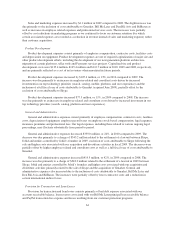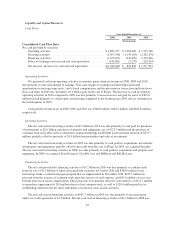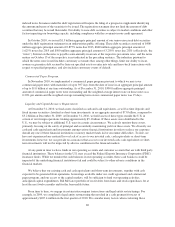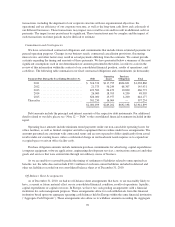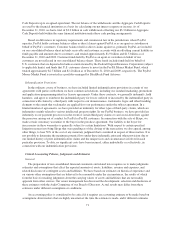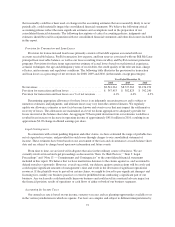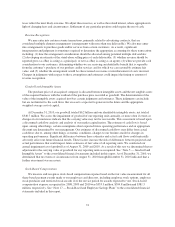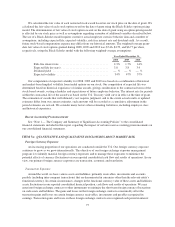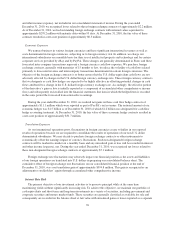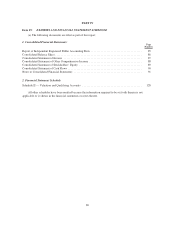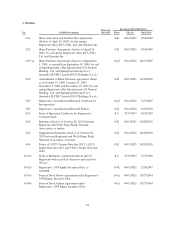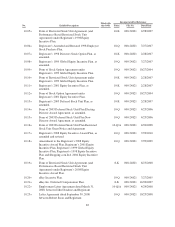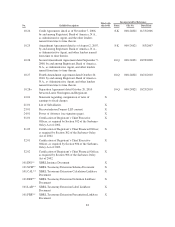eBay 2010 Annual Report Download - page 79
Download and view the complete annual report
Please find page 79 of the 2010 eBay annual report below. You can navigate through the pages in the report by either clicking on the pages listed below, or by using the keyword search tool below to find specific information within the annual report.taxes reflect the most likely outcome. We adjust these reserves, as well as the related interest, where appropriate in
light of changing facts and circumstances. Settlement of any particular position could require the use of cash.
Revenue Recognition
We may enter into certain revenue transactions, primarily related to advertising contracts, that are
considered multiple element arrangements (arrangements with more than one deliverable). We also may enter
into arrangements to purchase goods and/or services from certain customers. As a result, significant
interpretation and judgment is sometimes required to determine the appropriate accounting for these transactions
including: (1) how the arrangement consideration should be allocated among potential multiple deliverables;
(2) developing an estimate of the stand-alone selling price of each deliverable; (3) whether revenue should be
reported gross (as eBay is acting as a principal), or net (as eBay is acting as an agent); (4) when we provide cash
consideration to our customers, determining whether we are receiving an identifiable benefit that is separable
from the customer’s purchase of our products and/or services and for which we can reasonably estimate fair
value; and (5) whether the arrangement would be characterized as revenue or reimbursement of costs incurred.
Changes in judgments with respect to these assumptions and estimates could impact the timing or amount of
revenue recognition.
Goodwill and Intangible Assets
The purchase price of an acquired company is allocated between intangible assets and the net tangible assets
of the acquired business with the residual of the purchase price recorded as goodwill. The determination of the
value of the intangible assets acquired involves certain judgments and estimates. These judgments can include,
but are not limited to, the cash flows that an asset is expected to generate in the future and the appropriate
weighted average cost of capital.
At December 31, 2010, our goodwill totaled $6.2 billion and our identifiable intangible assets, net totaled
$540.7 million. We assess the impairment of goodwill of our reporting units annually, or more often if events or
changes in circumstances indicate that the carrying value may not be recoverable. This assessment is based upon
a discounted cash flow analysis and analysis of our market capitalization. The estimate of cash flow is based
upon, among other things, certain assumptions about expected future operating performance and an appropriate
discount rate determined by our management. Our estimates of discounted cash flows may differ from actual
cash flows due to, among other things, economic conditions, changes to our business model or changes in
operating performance. Significant differences between these estimates and actual cash flows could materially
adversely affect our future financial results. These factors increase the risk of differences between projected and
actual performance that could impact future estimates of fair value of all reporting units. We conducted our
annual impairment test of goodwill as of August 31, 2009 and 2010. As a result of this test we determined that no
adjustment to the carrying value of goodwill for any reporting units was required. See “Note 5 — Goodwill and
Intangible Assets” to the consolidated financial statements included in this report. As of December 31, 2010, we
determined that no events or circumstances from August 31, 2010 through December 31, 2010 indicated that a
further assessment was necessary.
Stock-Based Compensation
We measure and recognize stock-based compensation expense based on the fair value measurement for all
share-based payment awards made to our employees and directors, including employee stock options, employee
stock purchases and restricted stock awards over the service period for awards expected to vest. Stock-based
compensation expense recognized for 2008, 2009 and 2010 was $353.3 million, $394.8 million and $381.5
million, respectively. See “Note 17 — Stock-Based and Employee Savings Plans” to the consolidated financial
statements included in this report.
74


